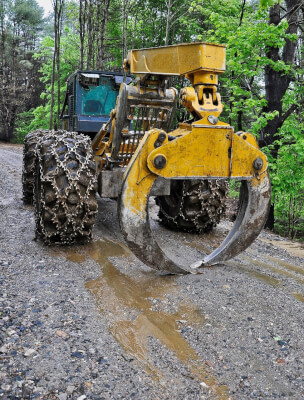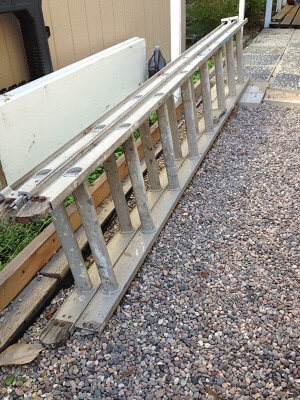
Emergency equipment can be expensive!
Considering an equipment purchase for your neighborhood group? Something BIG, like in the image above?
Not that you’re considering purchasing a log mover — I used the picture because it makes the point. This probably isn’t something you could afford by yourself. You certainly wouldn’t want to buy it and have it sitting around “just in case.”
But what if your group does need neighborhood emergency equipment?
On one hand, buying as a group makes it easier.
If you are part of a group, you can look at buying big items from a different perspective.
- You and your neighbors can get access to items you wouldn’t otherwise be able to afford.
- Your neighborhood can achieve a whole new level of resilience.
- Sharing in the purchase decision automatically creates a stronger network of neighborhood first responders!
However, big purchases are not all about big benefits.
Neighborhood emergency equipment decisions take a lot more thought.
For example, here are some of the decisions you’ll have to make about that purchase:
- Who will be the named owner – for tax purposes, for registration purposes, etc.?
- Which neighbor/s will be responsible for maintenance and repairs?
- Where will the equipment be stored and who will have access?
Here’s some of what we’ve experienced when we started buying materials for the group.
Some people don’t want to play.
People may be willing to show up to meetings. But being a member of the group isn’t enough to make everyone volunteer to spend money for the group’s welfare.
Honestly, we have found nothing that will change a “me” focus to an “us” focus. It’s either there, or it isn’t. So, if some of your group members seem unwilling to participate in group purchases, after appealing a couple of times to the concepts of cooperation and mutual support, you’ll have to let them go their own way.
Others are willing to buy for themselves and share when necessary.

In our local neighborhood, when we began to organize our group, it just so happened that we were already “sharing” a number of items. For example, Joe and I had a tall extension ladder that was left behind (too tough to pack) when a neighbor moved. The ladder ended up behind our house (see the photo!), and was used by any of a handful of people on the street. They just came and got it and brought it back when they were done.
After our first neighborhood emergency equipment inventory, we discovered that one contractor neighbor stores a heavy duty pry bar (six feet long) that he would be willing to share. Another neighbor has a pair of giant shears, good for breaking open chained gates. We have solar battery chargers.
We all learned about these items, and where they are located, and in an emergency we plan to share for the benefit of the group.
Getting money for “REALLY BIG” purchases.
When it comes to more expensive items, you may have to look at other options for financing them. Whatever you decide on, start now to put together your “wish list” of equipment your group could use effectively. Your list will be different from other groups’ lists. Just the action of making the list will involve more people and likely uncover creative ways to turn it into reality.
Option One – Funding from within the local community.
In our case, thanks to a committed and enlightened homeowners’ association board, our emergency team gets money every month via association dues. Emergency Plan Guide readers who are renters have told us their groups have received financial support from their property owners.
Some of our readers are members of groups incorporated as non-profits – and they have been the recipients of donations from local stores and local insurance companies. One group buys and resells radios at a profit.
Option Two – Funding from local or national grants.
Naturally we have looked for grant money. As a community we’ve been the grateful recipient of a grant co-sponsored by the Fire Department and First Alert. Three years ago, over a 2-day period, our team helped install donated smoke alarms in every single residence in the neighborhood!
As for getting grants on our own, we have had no luck so far. We have researched — and here’s some of what we have discovered.
- It helps, and often is required, that you be an established group, with an official non-profit status, ID number, etc. Federal (FEMA) grants usually go only to official government agencies – fire departments, etc.
- Private foundations usually have a specific focus (which may change from year to year) and may have a minimum award that is higher than you can justify asking for.
- Your request for money to solve a particular need with a one-time purchase of equipment — for example, communications equipment for handicapped or senior members – may be more positively received than a request for money for operations.
- Many grants are announced on a specific date. The organizations involved have a strict application procedure that may take months, so you need to start your investigation now. (See this Advisory about the grants from State Farm.)
- Your city may offer grants for specific activities. And, of course, your city or county may offer CERT training to all your group members, with no real strings attached.
Remember that grants, unlike donations, always come with strings attached. You have to meet the grant’s requirements and then show that you spent the money the way you promised you would.
Option Three — Sponsoring a fundraiser for your group.
This is the tried and true way for any community group to raise money – money they can spend any way they like. There are SO MANY ideas of how to put on a good fundraiser! You could probably write this section of the Advisory yourself!
Here are a few questions to get the conversation started . . .
What’s the purpose for the fundraiser? Sometimes it’s easier to have one specific goal (“$450 for walkie-talkies for our group”) rather than a generic “support our group” message.
Who would be a natural partner for the fundraiser? Usually, this means a commercial entity that would benefit from the exposure, or from direct sales. We have had good luck getting support from emergency equipment manufacturers and local hardware stores. If the commercial group is going to sell their products, you’ll have to figure out how your group will benefit!
What will attract visitors and make them want to pull money out of their pockets!
- Fun fair! If your audience has kids, parents will bring them along if there is plenty for kids to do! (“Oh, a good Saturday afternoon outing for the family.”) In all the years I’ve done events, the ONE MOST POPULAR ACTIVITY has always been “Spin the wheel and win!” Obviously this requires a wheel, lots of little prizes, and a few big ones!
- Bake sale – always popular in a venue where there’s lots of foot traffic
- Ice cream social – Get donated supplies!
- Yard sale with proceeds to benefit the group. (Combine with other community event or annual sale?)
- Speaker/local band willing to perform for the publicity
- Raffle for a great prize (Be sure you know the GAMBLING RULES for your state!)
What sort of location do we need, and where can we find it?
Do we have the equipment we’ll need? Tents, tables, chairs, microphone
How will we manage publicity?
What and how many volunteers do we need, what skills, with what schedule?
You’ll find many more resources online or at the library. If you would like a copy of my own well-tested Master List for Event Planning, just drop me a line!
How we’ve made neighborhood emergency equipment purchases for our own group.
Over the years we’ve held events like the ones suggested above. Some were really profitable — like when we sold a bunch of donated furniture at a yard sale. Others were barely profitable. But with the help of fund raisers plus budget from our HOA, our group has purchased medical supplies, walkie-talkies and their batteries, and pop-up tents. Our group also owns two natural gas “sniffers,” two refrigerators, a generator, a portable loud-speaker, three loud-hailers and some big floodlights. (We have chosen not to store food or water. We encourage our families to manage their own supplies for sheltering in place.)
Naturally, it takes an organized campaign to get a financial commitment of ANY SORT. In our case,
- We apply professional marketing planning and presentations. (Joe’s and my background is in direct marketing!)
- Fortunately, we have a couple of neighbors who love the challenge of coming up with donated gift cards!
- A couple of our members have jumped in to take on money management.
- Other members are enthusiastic HAM radio operators, and they provide guidance and training for the rest of us.
- Working with the fire department makes it possible for us to get a ladder truck and fire engine once in a while for “show and tell!”
Working together, we have been able to get financing for the big equipment we’ve needed so far for our group. It will take another Advisory to discuss how we set the priorities for using the equipment!
Virginia Nicols
Your Emergency Plan Guide Team
P.S. What sorts of fund-raisers have you been successful with? Let us all know by jumping down below the subscribe info and leaving a comment!
Don't miss a single Advisory.
Thank you for subscribing.
Something went wrong.
